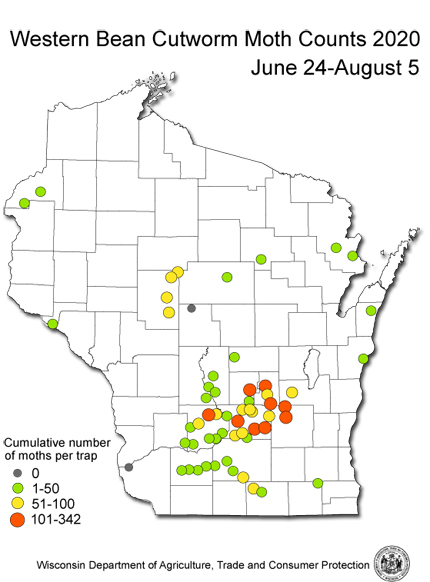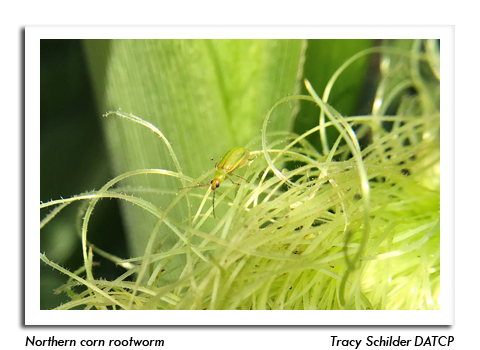
 |
|
|
Corn
Volume 65 Number 14 Date 08/06/2020 WESTERN BEAN CUTWORM - Moth counts have declined at southern and central monitoring locations. The trap in Green Lake County that captured 231 moths last week caught 67 this week, and numbers fell at 49 of DATCP's 58 monitoring sites. The network's total weekly capture of 776 moths is a sharp decrease from 1,589 last week when the flight peaked at many locations. As of August 6, the state cumulative total is 3,455 moths in 58 traps (60 per trap average.) The highest individual count for the seven-week monitoring period is 342 moths near Princeton in Green Lake County. Larvae produced by the annual flight were recently observed in Adams, Buffalo, and Trempealeau counties. CORN ROOTWORM - DATCP's annual beetle survey is now in progress. Counts in the 61 grain corn fields sampled July 30-August 1 were generally low to moderate, with 21 fields (34%) averaging from 0.1-0.7 beetles per plant and 29 (46%) of sites having no detectable beetle population. Above-threshold averages of 0.75 or more beetles per plant were observed at 12 (20%) of the sites, including very high counts of 3.0-5.6 beetles per plant recorded in Dodge, Green Lake and Marathon counties. Corn producers should be aware of the potential for corn rootworm adults to redistribute from earlier silking fields to later-planted fields as beetle emergence continues. Now is the time to scout to determine this season's beetle pressure and to forecast the risk of larval root injury to continuous corn in 2021. EUROPEAN CORN BORER - The treatment window for second-generation larvae will close in two weeks across southern and portions of central Wisconsin. Final inspections should be performed before degree day accumulations surpass 2,100 (modified base 50°F) and larvae begin boring into corn stalks. The predominant larval stages found this week were the 2nd and 3rd instars. JAPANESE BEETLE - This insect is still common on silks in cornfield margins. The highest beetle pressure noted during recent surveys has been in Crawford, Grant, Green, Lafayette, Dunn and Pepin counties in the southwest and west-central districts. As a reminder, a fieldwide average of three or more beetles per ear is considered high and may be a concern for fields not yet pollinated. CORN EARWORM - Migration flights continued during the first week of August. The highest pheromone trap count reported was 78 moths at Arlington in Columbia County, while other monitoring sites captured fewer than 10 moths. The earworm caterpillars noted August 3-5 in the west-central and central areas were about ¾-1¼ inches long. Routine scouting for larvae should be underway in fresh market and processing sweet corn. REDHEADED FLEA BEETLE - This flea beetle has been unusually common on a variety of crops and nursery plants this summer. Surveys on July 30 in Marathon County found particularly heavy populations. According to the field specialist's report, the beetles were abundant on corn leaves (<5-8 per leaf), where they were causing noticeable windowpane injury. Leaf feeding by this species is usually not damaging to reproductive corn, but fruits, vegetables and nursery stock in northern and central Wisconsin should be monitored for late-season flea beetle defoliation. -- Krista Hamilton, DATCP Entomologist 


.jpg)
.jpg)

|
|
|